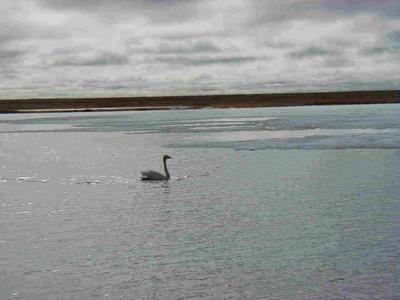
|
|
10 July, 2002
July 10, 2002
A real summer day! Highs must have been close to 70, blue skies and
barely a breeze! With a walk along Wyoming Creek to do bird work, I
don't know that it could have gotten much better for an arctic day!
On today's agenda was a trip to Cheyenne Marsh (SE of camp about 3.5
miles) to re-check nests. I always enjoy walking along the river as
the types of birds and plants vary so much from those found near the
wetter, marshy areas formed from frost heaves and permafrost
cracking. Although the number of birds is down, as I've mentioned
before, I still saw and heard one of my favorites - the rock
ptarmigan. When this 'guy' calls out, I always think of how much a
teenage boy would envy it. Its call sounds like he is talking while
he is burping Š.. it is sort of a croaking with syllables, I guess.
Both it and its closest relative up here, the willow ptarmigan, make
me laugh when they call! I only had the good fortune to see two of
these today, but I appreciated both.
In addition to the ptarmigan, I had a special treat today. I watched
and photographed 2 different groups of white-fronted geese with their
gosling swim down the river. Of course, I got a little too excited,
and ran to catch up to them - which only sped up their progress. But
the river bends sharply at places, so I made some cuts to catch up
and was elated with some views. The parents would squawk and make all
sorts of racket. At times they would run on the water or one may fly
away. But it was the goslings I enjoyed the most. When their parents
would 'tell them', they would speed up their swimming a little, or
some of them would dive under the water to hide. They would also
'cry' a little, but I was impressed by the way they stayed focused on
their parents and continued a steady swim in the direction their
parents were moving. Pretty brave little things - probably only 3-5
days old, too!
It does amaze me how water birds hatch with feathers ready to go. And
more - how within just a couple of days, the parents get the young in
the water for a steady swim and walk north to the Arctic Ocean. They
move through the marshes, weeds, rivers, and tundra polygons,
following their parents Š. And I don't believe they ever complain!
Truly, the fact that hatching and incubating works so well that the
young have the strength to travel that much ground is incredible.
Back to what I did today (besides enjoy the movements and sounds
around me). At Cheyenne marsh were 3 white fronted goose nests I
needed to recheck, as well as one tundra swan nest. Unfortunately,
the tundra swan's eggs had been depredated. Both parents were still
swimming around, probably taking advantage of the rich pond bottom
food, before they begin their migration south. The three goose nests
were also without their eggs, but it appeared that at least some of
the eggs hatched successfully. When I visit a nest and determine if
it was depredated or successful, I look at the condition of the egg
shells. If the egg shell is absent, the culprit probably removed it
and fed somewhere else. If the egg shell is in mainly one or two
pieces, or maybe looking like it had a 'bite' taken out of it, it was
also probably depredated. On the other hand, if the egg shell is in
many pieces, and more importantly there are egg shell membranes
present, they probably successfully hatched. The membrane may be
separate or still attached to the egg shell pieces. It will look like
a whitish, leathery membrane which used to line the egg shell..
To end such a rewarding day, I even fished a little in the creek on
the walk back to camp. And, yes, I did have luck! After just 3 casts
with my spinner, a very nice grayling thought it was hungry, bit and
found itself on a dry bluff. I proceeded to use my leather man, put
it out of its misery, and then clean it right there. What an end to
an arctic day - fried grayling, red beans and rice, and stir-fried
bell peppers, onions and carrots to top it off. I am wondering if I
ate any better when I was 'back in civilization'?? Even now, as I sit
typing (and re-typing much of this) in my tent, mosquitoes buzzing
around and sucking blood from my hands and temple area, I can't say
that I would want it any other way. I hope I am not asking too much
for another day like this tomorrow!

This is a picture of one of the swans I've been observing. Such a beautiful bird! --
Contact the TEA in the field at
.
If you cannot connect through your browser, copy the
TEA's e-mail address in the "To:" line of
your favorite e-mail package.
|
